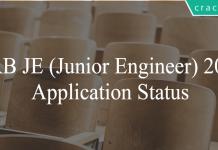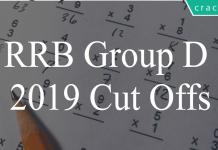Square Root Questions for RRB Group-D PDF
Download Top-15 RRB Group-D Square root Questions PDF. RRB GROUP-D Maths questions based on asked questions in previous exam papers very important for the Railway Group-D exam.
Download Square Root Questions for RRB Group-D PDF
Download RRB Group-D Previous Papers PDF
Take a RRB Group-D free mock test
Question 1: The square root of $27-4\sqrt{35}$ is :
a) $\pm(\sqrt{5}+2\sqrt{7})$
b) $\pm(\sqrt{5}-2\sqrt{7})$
c) $\pm(\sqrt{7}-2\sqrt{5})$
d) $\pm(\sqrt{7}+2\sqrt{5})$
Question 2: What is the square root of $214 – 78\sqrt{5}$
a) $13-3\sqrt{5}$
b) $17-4\sqrt{5}$
c) $13-6\sqrt{5}$
d) $17-3\sqrt{5}$
Question 3: What is the square root of 97-16$\sqrt{3}$
a) 9-4$\sqrt{3}$
b) 9+4$\sqrt{3}$
c) 7-4$\sqrt{3}$
d) 7+4$\sqrt{3}$
Take a free mock test for RRB Group-D
770 Mocks (cracku Pass) Just Rs.199
Question 4: Find the square root of discriminant of $2x^2-3x-7 = 0$ ?
a) 65
b) $\sqrt{65}$
c) 56
d) $\sqrt{56}$
Question 5: What can be said about the roots of the following equation $3x^2 – 5x + 4 = 0$
a) They are real and distinct, but one root is not square of the other
b) They are real and distinct, and one root is a perfect square of the other
c) They are real and equal
d) They are complex
Question 6: Sum of the squares of the roots of a quadratic equation is 25 and the product of the roots of the equation is -12. Which of the below four equations can be the quadratic equation –
a) $z^2+3z-12=0$
b) $z^2-z-12=0$
c) $z^2-3z-12=0$
d) $z^2+4z-12=0$
RRB Group D previous year papers
Question 7: If one of the roots of the equation $ x^2 + kx – 27 = 0$ is a square of another. What is the value of k?
a) -2
b) -4
c) -6
d) 2
Question 8: The square root of $33-4\sqrt{35}$ is :
a) $\pm(2\sqrt{7}+\sqrt{5})$
b) $\pm(\sqrt{7}+2\sqrt{5})$
c) $\pm(\sqrt{7}-2\sqrt{5})$
d) $\pm(2\sqrt{7}-\sqrt{5})$
Question 9: The greatest 4 digit Number which is a perfect square, is
a) 9999
b) 9909
c) 9801
d) 9081
Question 10: What is the positive square root of $[19+4\sqrt21]?$
a) $\sqrt{7}+2\sqrt{3}$
b) $\sqrt{3}+2\sqrt{7}$
c) $\sqrt{2}+3\sqrt{7}$
d) $\sqrt{7}+3\sqrt{3}$
RRB Group-D Important Questions (download PDF)
Question 11: What is the square root of $\frac{(3-2\sqrt2)}{(3+2\sqrt2)}$ ?
a) $3-2\sqrt2$
b) $3+2\sqrt2$
c) $1$
d) $17$
Question 12: What is the square root of $\frac{(3-2\sqrt2)}{(3+2\sqrt2)}?$
a) $3-2\sqrt2$
b) $3+2\sqrt2$
c) $1$
d) $$17$
Question 13: What is the positive square root of $[25+4\sqrt{39}]$ ?
a) $\sqrt{13}+2\sqrt3$
b) $\sqrt{13}+3\sqrt2$
c) $\sqrt{11}+2\sqrt3$
d) $11+3\sqrt2$
Question 14: What is the square root of 156.25
a) 13.5
b) 15.25
c) 10.5
d) 12.5
Question 15: The smallest positive integer to be added to 5467 to make it a perfect square is?
a) 9
b) 11
c) 17
d) 25
General Science Notes for RRB Exams (PDF)
RRB Group-D Important Questions (download PDF)
Answers & Solutions:
1) Answer (C)
We have to find $27-4\sqrt{35}$
We can write it as :
= $\sqrt{{27} – 2 \times 2\times \sqrt{5} \times \sqrt{7}}$
Since, $(a^2 + b^2 – 2ab) = (a-b)^2$
= $\sqrt{(2\sqrt{5})^2 + (\sqrt{7})^2 – 2\times2\sqrt{5}\times\sqrt{7}}$
= $\sqrt{(\sqrt{7} – 2\sqrt{5})^2}$
= $\pm(\sqrt{7} – 2\sqrt{5})$
2) Answer (A)
we have $(a-b)^{2}$=$a^{2}+b^{2}-2ab$
Comparing this with $214-78\sqrt{5}$ = $a^{2}+b^{2}-2ab$
We have 214=$a^{2}+b^{2}$
& $ab = 39\sqrt{5}$
For a=13 and b=3$\sqrt{5}$; 2ab=2*13*3$\sqrt{5}$
And so required answer is 13-3$\sqrt{5}$
3) Answer (C)
we have $(a-b)^{2}$=$a^{2}+b^{2}-2ab$
Comparing this with 97-56$\sqrt{3}$=$a^{2}+b^{2}-2ab$
We have 97=$a^{2}+b^{2}$
For a=7 and b=4$\sqrt{3}$ it gets satisfied and also 2ab=2*7*4$\sqrt{3}$
So the $(7-4\sqrt{3})^{2}$=$7^{2}+(4\sqrt{3})^{2}-2*7*4*\sqrt{3}$
And so required answer is 7-4$\sqrt{3}$
4) Answer (B)
Discriminant of $ax^2+bx+c=0$ is $b^2-4ac$.
Discriminant of $2x^2-3x-7 = 0$ is $(-3)^2-4(2)(-7) = 9+56 = 65$
Square root of discriminant = $\sqrt{65}$
So the answer is option B.
5) Answer (D)
$3x^2 – 5x + 4 = 0$
Finding discriminant of the given equation we have
$(-5)^2 – 4 *3*4$ = 25-48 = -23
Since discriminant<0
The roots are complex.
Hence, option D is the right answer.
6) Answer (B)
Let the roots of the equation be z and y.
$ z^2 + y^2 = (z+y)^2 – 2zy$
25 = (z+y)^2 +24
z+y = +1 or = -1
So, quadratic equation can be either $z^2+z-12=0$ or $z^2-z-12=0$
Hence, option B is the right answer.
7) Answer (C)
Given equation, $ x^2 + kx – 27 = 0$
Let a and $ a^2$ be the roots of the equation.
We have,
a * $a^2$ = -27
a = -3
Also, a + $a^2$ = -k
k = -6
Hence, option C is the right answer.
8) Answer (D)
To find : $\sqrt{33-4\sqrt{35}}$
We can write it as :
= $\sqrt{33 – 2 * 2 * \sqrt{7} * \sqrt{5}}$
Since, $(a^2 + b^2 – 2ab) = (a-b)^2$
= $\sqrt{(2\sqrt{7})^2 + (5)^2 – 2*2\sqrt{7}*\sqrt{5}}$
= $\sqrt{(2\sqrt{7} – \sqrt{5})^2}$
= $\pm(2\sqrt{7}-\sqrt{5})$
9) Answer (C)
Since the number has 4 digits, its square root will always have 2 digits.
=> Greatest 2 digit no. = 99
Greatest 4 digit no. which is perfect square = $99^2$ = 9801
10) Answer (A)
Expression : $[19+4\sqrt21]?$
= $[19+2\sqrt{4\times21}]=[19+2\sqrt{84}]$
= $7+12+2\sqrt{7\times12}$
= $(7)^2+(12)^2+2\sqrt{7\times12}$
Now, we know that $a^2+b^2+2ab=(a+b)^2$
= $(\sqrt{7}+\sqrt{12})^2$
Thus, square root is = $\sqrt{7}+\sqrt{12}$
= $\sqrt7+2\sqrt3$
=> Ans – (A)
11) Answer (A)
Given : $x=\frac{(3-2\sqrt2)}{(3+2\sqrt2)}$
To find : $\sqrt{x}$
Solution : rationalizing the denominator, we get
=> $\frac{(3-2\sqrt2)}{(3+2\sqrt2)}\times\frac{(3-2\sqrt2)}{(3-2\sqrt2)}$
= $\frac{(3-2\sqrt2)^2}{(3)^2-(2\sqrt2)^2}$
= $\frac{(3-2\sqrt2)^2}{9-8}$
=> $x=(3-2\sqrt2)^2$
Taking square root on both sides,
=> $\sqrt{x}=3-2\sqrt2$
=> Ans – (A)
12) Answer (A)
Expression : $\frac{(3-2\sqrt2)}{(3+2\sqrt2)}$
Rationalizing the denominator,
= $\frac{(3-2\sqrt2)}{(3+2\sqrt2)}\times\frac{(3-2\sqrt2)}{(3-2\sqrt2)}$
= $\frac{(3-2\sqrt2)^2}{(3+2\sqrt2)(3-2\sqrt2)}$
= $\frac{(3-2\sqrt2)^2}{9-8}=(3-2\sqrt2)^2$
Thus, square root is = $3-2\sqrt2$
=> Ans – (A)
13) Answer (A)
Expression : $[25+4\sqrt{39}]$
= $[25+2\sqrt{4\times39}]=[25+2\sqrt{156}]$
= $13+12+2\sqrt{13\times12}$
= $(13)^2+(12)^2+2\sqrt{13\times12}$
Now, we know that $a^2+b^2+2ab=(a+b)^2$
= $(\sqrt{13}+\sqrt{12})^2$
Thus, square root is = $\sqrt{13}+\sqrt{12}$
= $\sqrt13+2\sqrt3$
=> Ans – (A)
14) Answer (D)
$15625 = 5*3125 = 25*625 = 25^3 = 5^6$
Hence, $\sqrt{15625} = 5^3 = 125$
Therefore, $\sqrt{156.25} = 12.5$
15) Answer (A)
Lets try to find the rough vicinity of the square root of 5467. $70^2 = 4900$ and $80^2 = 6400$. Hence, the number is between 70-80. $75^2 = 5625$. Hence, the number is between 70-75 and is likely to be close to 75. We see that $74^2$ = 5476. Hence, we need to add 9 to make 5467 into a perfect square.
DOWNLOAD APP FOR RRB FREE MOCKS
We hope this Square root Questions for RRB Group-D Exam will be highly useful for your preparation.





